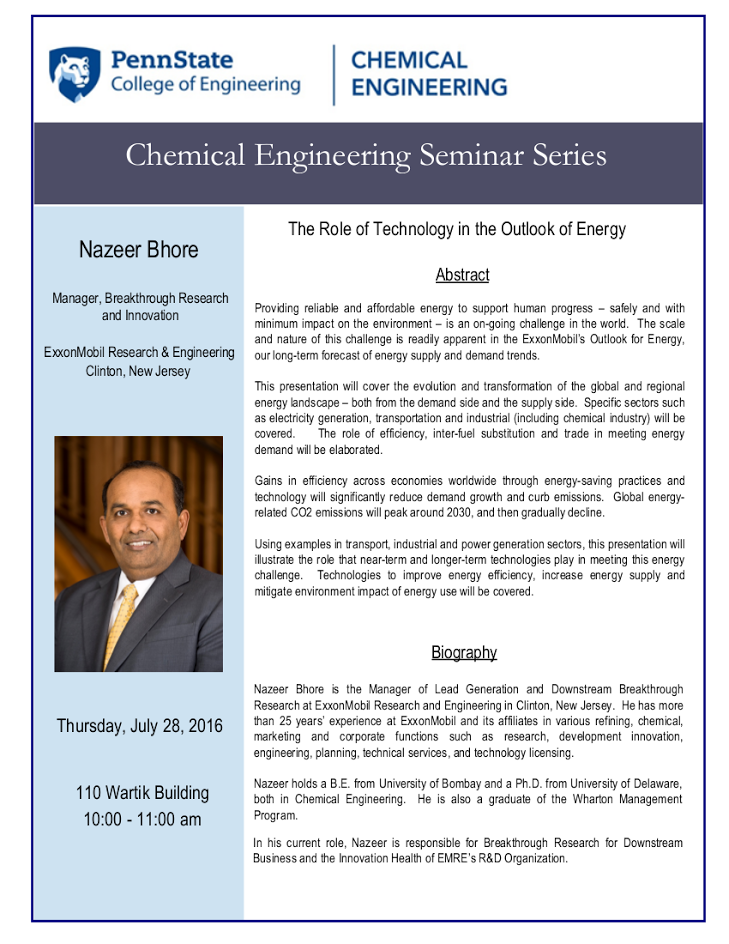The ChE GSA is starting a new monthly column that will feature one of the research groups in our department. Our first group is Dr. Phil Savage’s group.

(Top row, left to right) Jonathan Harcourt, Zach Berquist, Nate Kokinski, Phil Savage
(Bottom row, left to right) Xian Wu, Xueying Zhao, Jimeng Jiang, Lili Qian, James Sheehan
We have asked the graduate students within Dr. Savage’s group questions related to their research and here are some of their responses.
So let’s start off with a small ice-breaker ChE style, what is your favorite equation of all time?
Jimeng Jiang: My favorite equation is Fenske equation because Fenske is an alumni of Penn State!
James Sheehan: One of my favorite equations is the residual sum of squares due to its simplicity and robust use in optimization.

Xueying Zhao: My favorite equation is mass balance because it is an important equation in chemical reaction and we can derive other equations from it.
Jonathan Harcourt: I don’t really have a favorite equation. However, if I was forced to chose I would say the fundamental equation of thermodynamics, because it can be used to derive all of the other equations in classical thermodynamics.
Let’s talk more about your research. I understand that Dr. Savage’s research focuses on biofuels. What is your project and what is the major problem that your project is trying to solve?
James Sheehan: My current research focuses on the hydrothermal liquefaction (HTL) of proteins. HTL is a thermochemical process that uses water at elevated temperatures (200 – 400oC) and pressures (10 MPa – 40 MPa) to transform biomass into biocrude-oil, a renewable fuel precursor. Biomass feedstocks are often rich in proteins and understanding their involvement in HTL is pertinent to producing high quality biocrude-oil. My research interests are identifying and modeling the reaction pathways involving proteins during HTL and their incorporation into biocrude-oil and recovery as valuable co-products such as amino acids or other nutrients.
Jimeng Jiang: My research project is ‘Demetallation of Biocrude from Hydrothermal Liquefaction of Microalgae’. Biofuels have the potential to be an alternative fuel of petroleum in the future. I am trying to remove the detrimental metals such as iron and sodium from algal crude oil to improve the quality of crude oil.
Xian Wu: Catalytic Fast HTL of Micro-algae. With the increasing demand for fuel, the limited amount of the fossil fuels may be a potential cause of an energy crisis. Micro-algae, which could be raised rapidly and harvested without consuming arable land, has shown its great potential to be processed into bio-crude, which is regenerable fuel. Without drying the harvested micro-algae, HTL fulfills the goal of converting the bio-feedstock into energy-condensed fuel. Recently, research proved that Fast HTL provided a higher yield of bio-crude than isothermal HTL. My project involves identifying catalysts that increase the quantity and quality of the bio-crude through Fast HTL of micro-algae and conducting kinetic analysis on the catalytic fast HTL. The final goal of the research is to formulate a realistic model that can predict the process of catalytic fast HTL of micro-algae.
Jonathan Harcourt: My research focuses on the effect of salt water on the process of HTL. One of the most promising potential biomass feedstocks is microalgae, because of its rapid growth rate. Many of the fastest growing microalgae grow best in seawater. My research is investigating whether additional salts in seawater will affect the HTL process. I will also do the same for catalytic HTL, since different components of seawater (i.e. Cl- ions) are known to poison many of the best catalysts for HTL.
Xueying Zhao: My research project is hydrothermal liquefaction of a microalga with a core-shell catalyst. The major problem that I’m trying to solve is about the deactivation of catalyst in the reaction. I’m trying to use the shell to isolate the catalytic core with algae.
Lili Qian: My research project is the hydrothermal liquefaction of sludge, aimed to produce biocrude oil using municipal sewage sludge. This research is trying to solve the sludge disposal problems, such as secondary pollutants caused by incineration and landfills. Also, waste biomass can be converted to biocrude oil to solve the energy shortage problems.
Dr. Savage’s group at Penn State is relatively young (started in 2014), but has the group been able to publish any papers? Additionally, have you attended or will you attend any conferences in the near future?
James Sheehan: This past spring, we published a journal article regarding the HTL of soy protein concentrate (Products and Kinetics for Isothermal Hydrothermal Liquefaction of Soy Protein Concentrate). This upcoming August, I will be presenting at the ACS Conference in Philadelphia, PA on HTL of proteins.
Thank you members of Dr. Savage’s group for taking the time to talk about their group.


You must be logged in to post a comment.